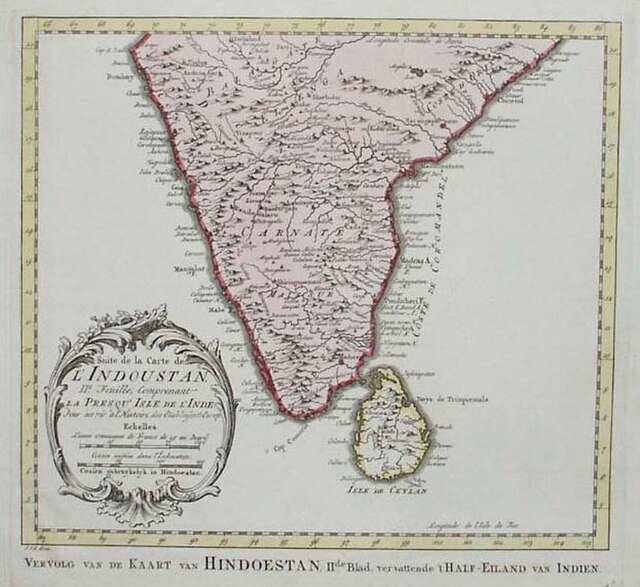French East India Company
The French East India Company was a joint-stock company founded in France on 1 September 1664 to compete with the English and Dutch trading companies in the East Indies. Planned by Jean-Baptiste Colbert, it was chartered by King Louis XIV for the purpose of trading in the Eastern Hemisphere. It resulted from the fusion of three earlier companies, the 1660 Compagnie de Chine, the Compagnie d'Orient and Compagnie de Madagascar. The first Director General for the Company was François de la Faye, who was adjoined by two Directors belonging to the two most successful trading organizations at that time: François Caron, who had spent 30 years working for the Dutch East India Company, including more than 20 years in Japan, and Marcara Avanchintz, an Armenian trader from Isfahan, Persia.
Coat of arms Motto: Florebo quocumque ferar Latin for "I will flourish wherever I will be brought"
French East India Company cannon ("Canon de 4"). Bronze, 1755, Douai.
Carte de L'Indoustan. Bellin, 1770.
French-issued copper coin, minted in Pondichéry, used for internal Indian trade.
The East India Company (EIC) was an English, and later British, joint-stock company founded in 1600 and dissolved in 1874. It was formed to trade in the Indian Ocean region, initially with the East Indies, and later with East Asia. The company gained control of large parts of the Indian subcontinent and colonised parts of Southeast Asia and Hong Kong. At its peak, the company was the largest corporation in the world by various measures and had its own armed forces in the form of the company's three presidency armies, totalling about 260,000 soldiers, twice the size of the British army at the time.
James Lancaster commanded the first East India Company voyage in 1601
Red Dragon fought the Portuguese at the Battle of Swally in 1612, and made several voyages to the East Indies
The emperor Jahangir investing a courtier with a robe of honour, watched by Sir Thomas Roe, English ambassador to the court of Jahangir at Agra from 1615 to 1618, and others
A document with the original vermilion seal of Tokugawa Ieyasu, granting trade privileges in Japan to the East India Company in 1613








